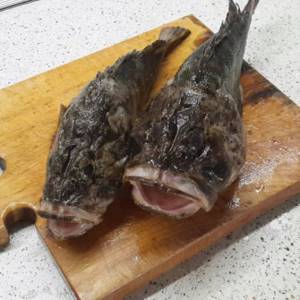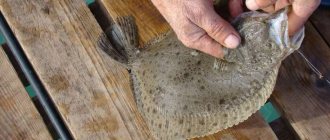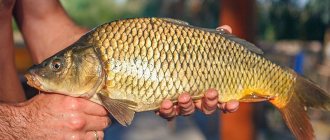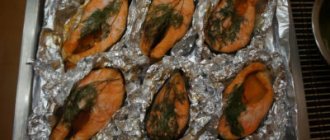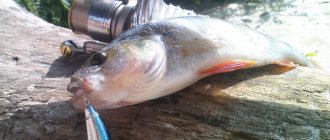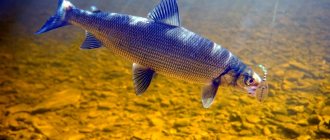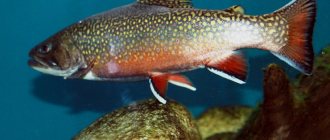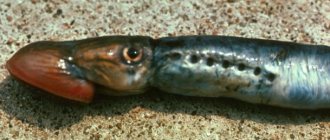The sea ruff, or scorpionfish, is a fish that, when you look at it, it’s difficult to think that it is edible. But for amateur fishermen, unlike its freshwater counterpart, this is a valuable trophy.
What is the most in your diet?
- Meat 43%, 141 votes
141 votes 43%141 votes - 43% of all votes
- Fruits and vegetables 24%, 79 votes
79 votes 24%
79 votes - 24% of all votes
- Dairy products and eggs 18%, 60 votes
60 votes 18%
60 votes - 18% of all votes
- Fish 15%, 51 votes
51 votes 15%
51 votes - 15% of all votes
Total votes: 331
18.04.2020
×
You or from your IP have already voted.
Content
- 1. General description of scorpion fish (sea ruff)
- 2. Distribution and habitats of fish
- 3. Age and size
- 4. Lifestyle
- 4.1 Reproduction - time and characteristics of spawning
- 4.2 Diet - what to eat
- 5.1 Biting calendar
- 5.2 In what weather does scorpionfish bite best?
- 5.3 What are the best places to fish?
- 5.4 What gear is best for catching scorpionfish (sea ruff)
- 5.5 Baits for catching scorpion fish (sea ruff)
- 5.6 What baits and baits to fish with
- 5.7 How the scorpion fish (sea ruff) bites
- 5.8 How to catch correctly - basic techniques
- 5.9 Highlights
Murmansk dried ruff: one of the most delicious fish in the world
Recently Sasha Volkov-Medvedev, chef of the Ruski restaurant, gave me a Murmansk ruff. He went to cook for the Teriberka festival and brought several pieces. He told me: “This is the most delicious dried fish in the world.” I asked him if he had ever eaten Azov bulls. Sasha said that he had eaten it and that the ruff tasted better. At this point I was a little incredulous. Because could there be anything tastier than dried bulls?
Murmansk ruff is a flounder. Here it is.
It is called a ruff for the hard ctenoid scales on the upper half. Ctenoid - that is, with a serrated outer edge. In general, ruff flounder is practically not caught en masse; it is caught as bycatch when cod is fished.
Sasha first learned about her in the army. He served in Murmansk. And then one day he was cleaning up after one general’s get-together, tried this fish - and since then he has been asking everyone who goes to Murmansk or comes from Murmansk to bring him ruff. “A super delicacy,” that’s how he briefly described this fish.
I tried it too. I expected the usual flounder dryness - but it turned out that the ruff is very fatty, and this fat is aromatic and tasty, and the meat is also rich in powerful flavors. The taste is even very reminiscent of dried caviar - both roach caviar and galagan, for example (this is dried mullet caviar, which in Italy is called bottarga).
I still won’t refuse gobies, but I agree with Sasha: this is an incredibly tasty fish.
Its usual use is, of course, as a snack for beer. But it’s a shame, damn it, that many great products are perceived only this way. This is naturally a delicacy. (Although the ruff is really wonderful with beer).
I shared my impressions with Sasha and asked what he would make from this fish. And he (and I didn’t tell him about the resemblance to caviar that occurred to me) said that he had already done it. One day his brush got quite dry, and he rubbed it like bottarga. I cooked spaghetti, added butter and ruff powder, mixed it and put it on plates: “It turned out to be a very tasty pasta.”
Alas, I have already eaten my ruff, I will now look for it.
And Sasha gave me another recipe: pasta with herring! You need to puree ordinary salted herring with butter in a blender, and then add it to the same spaghetti, for example: “For 1 serving, one hundred grams of salted herring, 60-70 grams of butter and a little water in which the pasta was cooked. The result is a very tasty sauce that perfectly envelops the pasta. Simple - and damn delicious. You can make the preparation and store it in the freezer - it’s also convenient.”
1. General description of scorpion fish (sea ruff)
The scorpionfish, also called the sea ruffe, has an oblong body, slightly compressed from the sides. A large head, slightly flattened, with large bulging eyes and a wide, thick-lipped mouth. Powerful jaws, armed with small teeth. There are growths of bristles in the pharynx, arranged in a semicircle, which act as graters
The body is covered with warts, spines, flaps of scales and tentacles of varying lengths, giving the fish a comical appearance. The dorsal fin consists of soft rays extending from the tail and spiny feathers extending across the entire back. The pelvic and pectoral fins, wide, oval in shape, like the anal fins, have spines along the edges. Gill scutes, fins and tuberous spines are equipped with needles, on the edge of which there are glands with poison. The color of the back is dark brown, the body is light brown.
Concept of sea ruffe and flounder
The fish known as ruff flounder is biologically called Hippoglossoidcs platessoides limandoides (BToch). Belongs to the genus Halibut flounder. There are 2 subspecies: the small European and the larger North American. The fish, which is simply called flounder, belongs to the genus Flounder and the species of the same name. Its zoological name in Latin is Pleuronectes platessa.
Lifestyle
A bottom predator that lives in coastal strips at a depth of 10–90 meters.
4.1. Reproduction - time and characteristics of spawning
June – September. Reaches sexual maturity at the age of 2 years, with a body length of 17.5 cm. Sizes may vary depending on habitat and ecology.
It spawns in portions, wrapped in transparent mucous membranes, which rise to the surface and ripen. The protective veil bursts, and the larvae are released and drift in the water column. Very soon, already in the form of juveniles, they sink to the bottom, continuing their way of life in their native element.
4.2. Diet - what to eat
Small fish, such as goby, greenfin and silverside, as well as crustaceans and molluscs (squid, cuttlefish, octopus).
Habitat and food
“Spiny” predators live at a depth of up to 3 meters in places with a sandy or gravel bottom. Ruffs try to stay near places surrounded by vegetation and large stones.
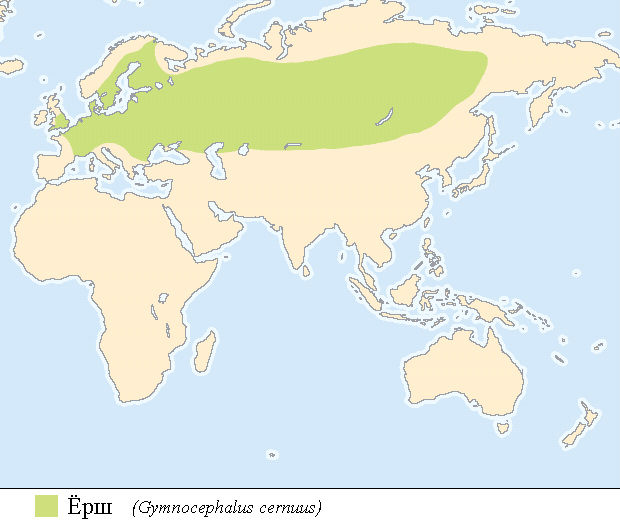
Habitat of Ruff in Eurasia
The River Ruff does not like sunlight, so it prefers to be in the shade. It does well in dark places.
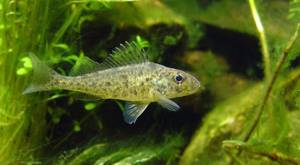
The fish become active in the early morning hours or in the evening. In cloudy weather, the activity of the inhabitants lasts throughout the day. The diet of “prickly” predators includes leeches, worms, and small species of fish.
How, where, when and what to catch scorpion fish (sea ruff)
You can fish from the shore and no less successfully from floating craft, around the clock, using both natural and artificial baits.
For lovers of fishing in sea waters, we suggest that you familiarize yourself with detailed information about the Mediterranean Sea, its weather conditions, relief, water temperature, water currents and inhabitants - Mediterranean Sea: description, history, interesting facts
5.1. Biting calendar - what time of year is the best time to bite?
Scorpionfish fishing is carried out all year round.
5.2. In what weather does scorpionfish bite best?
In the first hours after the storm.
5.3. What are the best places to fish?
In the morning and evening, near the shore, at a depth of at least 3 meters, on the slopes of a shell, coral or rocky bottom, as well as in the coastal zone, among stones, reefs and algae.
5.4. What gear is best to fish with?
When fishing from a boat, use a hard spinning rod with a sensitive tip. The coil is inertial, or inertialess.
The gear that is often successfully caught is assembled in this way:
- main line 0.40 mm, with a reserve on the reel of 50 m;
- at the end of the bet, sinker 50-100 g;
- leashes with a cross-section of 0.30 mm, attached to the main line using swivels;
- the size of the hook depends on the size of bait No. 5-9, in the amount of 2 pieces.
In clear water, in shallow water, so that the boat is not visible, the equipment is thrown to the side, and to make it easier to fish the ruff out of the stones, the hooks are equipped with floats, giving them a suspended state.
Since fishing for scorpionfish is mainly carried out in stones and algae, it is best to use a piece of reinforcement 20 - 30 cm long as a load, bending it into the Latin letter - V, instead of bending it, attach the fishing line and hooks in the stones and thickets there will be no more bottom.
From the shore they fish with float tackle, with a blind or sliding rig, depending on the depth and casting distance. The float should be made of foam plastic, white and large, and for fishing at night, it should be coated with Firefly varnish.
At night, scorpionfish are caught effectively and in large numbers on the bottom. An ordinary sinker, round or flat, will not work; the fish will be dragged into the stones, after which it will be problematic to fish it out.
When a scorpionfish bites, it detects itself and always does. It pecks and immediately swallows it. Taking these features into account, a thick wire is used as a sinker, which is bent into a ring. The ends of the rod are connected by soldering. The main fishing line with a carabiner fastens the ring - a sinker, to which leashes with hooks are tied.
And for those who are interested in braided fishing lines, the most detailed information about this type of fishing line is here
For the most detailed information about monofilament fishing line, its features, advantages and types, read here
The rig is thrown at a distance of 40 - 80 m from the shore. Dozens of pieces are thrown into the donok, and in the morning the catch is counted. One tackle can catch up to five individuals.
The bundle with the trophy can be easily released from the main line by opening the carabiner. After which, the scorpionfish is moved into a plastic bucket, or into some other dense container. On the way back from fishing, the fish will calm down, and at home, in a calm environment, remove the hooks from its mouth. Removing an aggressive ruff at night, even with a flashlight, is not always convenient or safe.
Tackle of this design has the following advantages:
- Minimum effort.
- High result.
- Convenient and safe to use.
In this 3-minute video, experienced fishermen will share with you their experiments with tackle and reels. Fishing is carried out with ultralight on a microjig, from the pier, in the city of Sochi
Ruff, rattling with its ammunition, and its appearance alone, pleases enthusiastic fishermen. Caught in the Black Sea, large size, brightly colored silicone
5.5. Bait for catching scorpion fish (sea ruff)
Seafood mixture: crustaceans, fish and shellfish (squid, cuttlefish, snails, mussels, octopus). Finely pound and pour into a nylon stocking. Then, they throw it into the place of upcoming fishing.
5.6. What baits and baits to fish with
The bait most often used is: raw or boiled rapana meat, mussels, small whole crab, as well as sliced fish (for example, sardines), nereis, shrimp and lard.
Delicacy – smarida fillet, chicken skin.
Silicone attachments - crustaceans, shrimp, worms, with the addition of attractants.
Jig, silver or green, with black spots. The result of the catch will increase if, in addition to the hook, you pick up sliced fresh fish.
A wobbler that works best is 3–7 cm long, with a depth of 1–3 m, green, brown or steel in color.
Detailed information about wobblers, their history of appearance, classification, fishing and wiring techniques. Methods for installing wobblers, storage and transportation rules, useful tips and much more, read here
5.7 How scorpion fish (sea ruff) bite
It grabs instantly and deeply, literally in a matter of seconds, the bait is already in the esophagus.
5.8. How to fish correctly. — Basic techniques
Wiring of any nozzle is used in steps, with a delay of 2-3 seconds.
5.9. The most important moments
Removing the hook from the mouth of the scorpionfish is no less important moment. Experienced fishermen take the ruff by the lower jaw with two fingers, thumb and index. But if you have no experience, then it is better to do this with a special tool, a clamp or a grip, so that the ruff cannot slip out of your hands and sting.
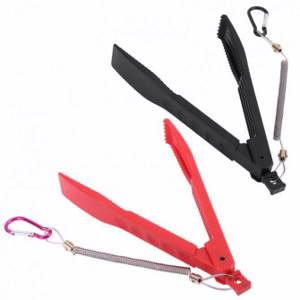
Buy a product on the aliexpress website
Geography of settlement and types
Small perch are unpretentious and thrive in cool and warm fresh water (from 0 to +35°C), choosing places with a sandy, rocky or moderately silted bottom. At the same time, the fish makes special demands on the availability of oxygen and current, avoiding stagnant, shallow and too fast areas. Such restrictions on gas exchange and constant renewal of the environment are key in determining the natural range of the ruffe, which lives only in large and small rivers, reservoirs, canals, flowing lakes and ponds.
To learn more:
The royal fish of the sturgeon family - sterlet
Due to its temperature resistance in Russia, “nadoeda” is found everywhere over a vast territory from North-Eastern Siberia (Kolyma, Sokha, Magadan region) to the western borders of the country. The common ruffe is found in all rivers of the Baltic, Black, Azov and Caspian seas. It is found in Lake Ladoga, Vuoksa, Khopra, Seversky Donets, Ural, Laba, Urup, Volga and its tributaries (Oka, Klyazma, Kama, Eruslan, Sura). Other species are more whimsical and live in regions with mild winters.
Don ruff
Gymnocephalus acerinus is also known by the common nicknames nosar, privet, beaver. On the territory of Russia it lives in reservoirs of the Black Sea-Azov basin (Don, Kuban). In Europe it is numerous in the Southern Bug, Dnieper, Dniester. It is distinguished by a wedge-shaped head with an elongated snout, a retractable mouth, a white belly, a light yellow back, weighs up to 200 g at 18-20 cm. It is listed in the Red Book of Ukraine as an endangered species.
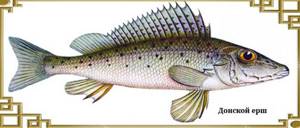
Ruff Baloni
Gymnocephalus baloni prefers deep running water near steep and shaded banks. Avoids soft bottoms, choosing sandy, clay, gravel or mixed areas for habitat. Lives up to 6 years and stretches up to 17-18 cm with a weight of 40-50 g. The main habitat is in the Morava, Vltava, Laba basins, which is why the taxon has a second official name - the Czech ruff. This fish is found in the Danube, the middle reaches of the Dnieper, and Pripyat. It differs from other species in its taller body with a hump, a short flattened snout, two spines on each gill cover, and a tiger-like gray-yellow color.
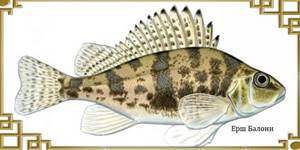
Striped ruff
Gymnocephalus schraetser lives in Germany, Bulgaria, Ukraine (Danube, Tisa, Kamcha). It is characterized by relatively large sizes - up to 30 cm (250 g). But standard catches are dominated by individuals weighing 50-80 g (15-18 cm). The main difference is the 3-4 full or dotted stripes on the olive-yellowish sides. The snout has an elongated shape (1.5 eye diameters) and ends with a semi-lower retractable mouth. The dorsal fused fin has 17-19 hard rays.
To learn more:
Tench: description of fish, habitats, spawning and fishing methods
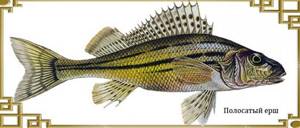
Black Sea ruffe
The species represents its own genus of scorpionfish (Scorpaena) and has only one distant resemblance to its lake-river namesake - a set of sharp spines. This exclusively marine fish is a cruel ambush predator, has a huge mouth with an elongated lower jaw and, as it grows, is capable of shedding its skin that has become tight like a snake. Another feature that makes the taxon similar to viperiformes is the presence of poison in the fins and bone spines on the body. The ruffed scorpionfish grows up to 40 cm and weighs about 800 g. The habitat is represented by the moderately salty waters of the Eastern Atlantic and the waters of the Black, Azov, and Mediterranean seas. This is a popular fish species because, when properly skinned and cooked, its meat is tasty and healthy.
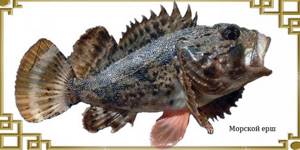
Interesting, unusual, funny facts about this fish
From the stories, underwater hunters and fishermen who experienced a ruffe bite described the symptoms differently. For example, in the Black Sea, the fish are calm and the bite is less painful. In the Mediterranean, after a bite, swelling follows and the temperature rises; the painful effect can last up to 2 days. In the Red Sea, after being pricked by a sea ruffe, there have been deaths, and the temperament of the scorpion fish species is more aggressive.
The toxicity and behavior of fish are influenced by two main factors - the number of enemies and the availability of food. In the Black Sea, most likely, there is an abundance of living creatures, but in the Red Sea, you have to fight for every shrimp.
In the case of a scorpionfish injection, no matter what sea it happened on, the first thing you need to do is remove the thorn from the wound. Then, squeeze out the blood so that the poison does not spread throughout the body. Disinfect the bite site with hydrogen peroxide; if this is not possible, then rinse the wound with sea or hot water. Even if the burn site does not bother you, you still need to go to the hospital to avoid infection or an allergic reaction.
The sea ruffe, unlike other fish, sheds. It does this in a very funny way: it rubs against stones or rocky ledges, and the scales peel off from the body of the fish, like a stocking. Once a month, the top cover is replaced, which protects the scorpionfish from parasites and dirt stuck to the scales.
On the head, the sea ruffe has receptors, thanks to which, even in the dark, it recognizes its prey by the slightest fluctuations.
Ruff swallowed a burbot the size of himself, and to place it in his stomach, he rubs it with pharyngeal brushes. At the time of the meal, an underwater diver swam up to wish you bon appetit. Watch 1 min. video
Characteristics of fish
The Sea Ruff has a size of up to 20 cm and has a variety of colors, which depend on the depth of the inhabited body of water. In deeper waters, the Ruff may have a black tint; in shallow rivers or lakes, its color changes to a dull green.
When pulled out of the water, the river fish Ruff, a photo of which can be seen below, spreads its fins, exposes its spines and points its tail towards its head. Because of this, it is called prickly, since the fins are sharp, and after being pricked, the wounds do not heal for a long time.
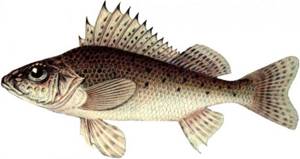
Another distinctive feature of Ruff is the mucus that covers his body. This fact has a negative impact on other marine life. If you place “slimy” fish in the same container with other marine representatives, after 30 minutes they will float up belly up.
The camouflage color and prickly spines of the fish perfectly protect it from the predatory inhabitants of reservoirs. Pike loves ruff, but when trying to eat the prey, it fails. The pike, when hooked, releases Ruff, this saves his life.
Aacute agriculture in China began to suffer more from poachers
Lures and fishing
There is no commercial fishing for these fish species, but they are sometimes found in bycatch. They are often caught by amateurs with a fishing rod - from boats and even from piers, choosing places above a rocky bottom covered with aquatic plants. Depth is needed from 3 meters or more. The best time for such fishing is in the summer after sunset, although ruffe can be caught in the sea at any time of the year. If you manage to go fishing immediately after a storm, a good catch is almost guaranteed. An important feature of catching it on a spinning rod with bottom tackle: you will need a bet, or, in extreme cases, just a sinker.
The sea ruffe is a predator, so as bait you need to use the meat of fresh fish, shellfish or crustaceans - natural food for this type of food. But in a pinch, pieces of chicken or horse mackerel will do. They do not provide bait. The sea ruff cannot get off the hook: the swallowed bait goes straight into the esophagus. But it’s easy to drag the tackle into the rocks and get entangled in the bottom relief. To avoid this, you can use not a spinning rod, but a sea circle.
Fishing for scorpion fish
They catch scorpionfish close to the shore. The most successful places for catching are considered to be piers, piers, rocks, as well as shores where there is a bottom with large stones and dense vegetation. Scorpion fish hunt in such places, so finding it among algae bushes and in rock crevices is quite easy.
You can catch scorpionfish on a hook throughout the year, but fishermen prefer to hunt sea ruffs in the summer. The fish is most active at night. There are no special requirements for gear - they can be very different. The best option would be: a spinning rod with installation of bottom tackle, as well as a sea circle.
Bait for sea ruffe
Bait for scorpion fish is used in rare cases. The ruffe will collect any bait, for example: crushed mussel shells, in a short period of time. You can use small pieces of horse mackerel.
For fishing for scorpionfish, the following is used as bait:
- Chicken and fish fillet.
- Boiled shrimp.
- Squid meat.
- Fresh shrimp.
- Small pieces of fish that were recently caught.
The scorpionfish has an excellent appetite, so it grabs prey that may exceed its size. The sea ruffe is not afraid of the rings of a spinning rod, and thanks to its gluttony, it quickly gets hooked.
How to catch scorpion fish correctly
Both with the help of a spinning rod and with the help of a sea mug, scorpionfish are caught in a plumb line. If fishing is done using a spinning rod, then you need to lower the bet to the very bottom, pick up the slack, and then make a stretch and wait for the bite. If the fish is caught, the fisherman first feels short-term constrictions, and then a strong jerk occurs. With such signs, you cannot hesitate, otherwise the scorpion fish will hide under the nearest boulder and then the bet will end, and you will be left without a catch.
If you use a marine circle, then you should lower the ring to the very bottom and then leave the tackle for about 20 minutes. In this case, there is no need to worry that the fish will escape, because the ring and small leashes will not allow it to go a great distance and catch and then break the tackle on the rocks.
How to remove a sea ruffe from a hook
Retrieving a caught scorpionfish is simple, but you should remember safety precautions and make sure that the spike does not injure the skin.
The poisonous spines of the scorpionfish are located:
- At the base of the dorsal fin rays.
- On the ventral fin at the base of the first ray.
- At the base of the three rays of the anal fin.
To remove the sea ruff from the hook, you need to press it with the handle of the rod and grab it by the lower lip with pliers. Then, in order to avoid injury from the thorns, they are trimmed with scissors. Next, the fish is removed from the hook without any threat to the fisherman’s health.
Sea ruff in the kitchen
Despite the fact that the scorpionfish looks scary, its juicy, white meat with a sweetish taste is considered a real delicacy . But you should remember that when cleaning caught fish, you should follow safety precautions , otherwise you can get hurt by its thorns . A large number of delicious dishes can be prepared from sea ruff. It is fried, boiled, dried, and used in aspic dishes and soups . Most often, this fish is baked in foil , and fish soup is also prepared . They say that ruff soup has a special taste.
An interesting fact is that sea ruffe meat, in addition to its excellent taste, affects men’s health. Therefore, for male fishermen and underwater hunters, the Black Sea scorpionfish is always a desirable prey.
External features
The sea ruffe grows very unusually. Like a snake, he sheds his old skin. This happens approximately once a month. Moreover, the more favorable the living conditions, the more often such molts occur.

Together with the old skin, it sheds clinging parasites and adhering algae. Thanks to its excellent camouflage, it is difficult to notice at the bottom, which is why the prey itself swims towards the scorpionfish.
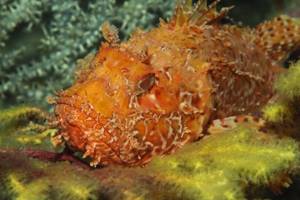
Due to its outgrowths, spiny fins and spotted color, the fish has a terrifying appearance.
This is what a sea ruff looks like:
- the average body length is about twenty-five centimeters;
- a large flattened head, covered with a spiky shell, occupies a third of the entire body;
- high-set, bulging eyes of a dark red color;
- the presence of poisonous spines on the ventral, dorsal and anal fins;
- the large mouth is framed by full lips;
- in strong jaws there are sharp, uneven teeth;
- camouflage pimples and flaps of skin cover the body, disguising the fish as a stone;
- the presence of hard pelvic fins in the anterior part of the belly.
